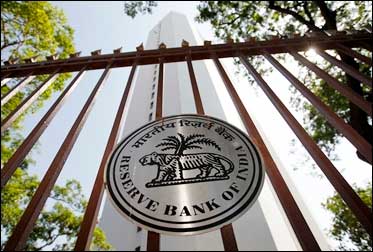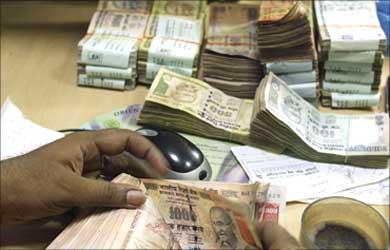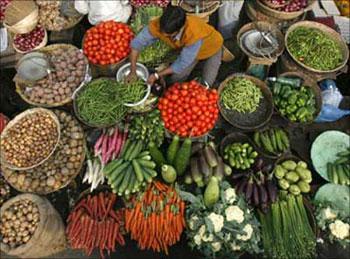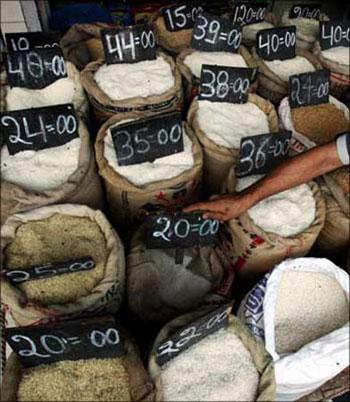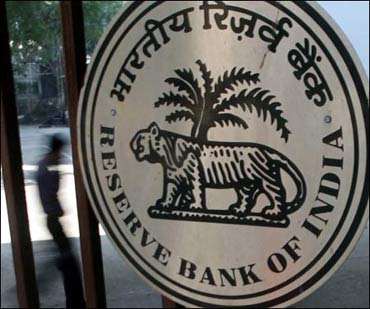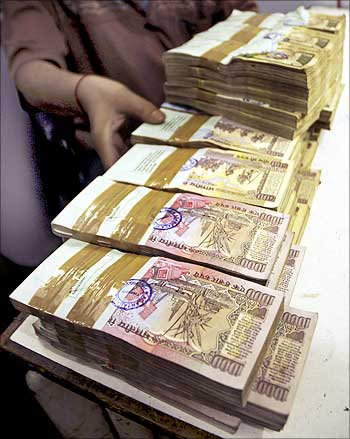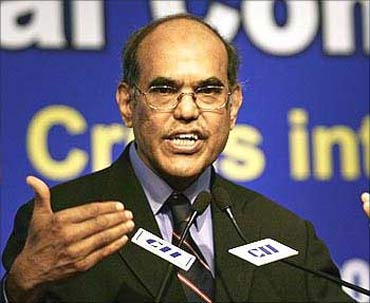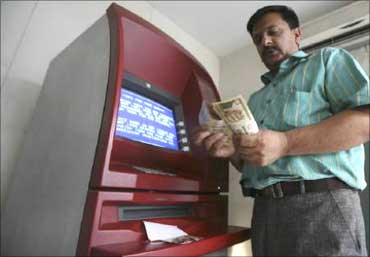 | « Back to article | Print this article |
RBI to infuse Rs 480 bn; raps govt for cash crunch
Click NEXT to read on...
RBI to infuse Rs 480 bn; raps govt for cash crunch
Click NEXT to read on
RBI to infuse Rs 480 bn; raps govt for cash crunch
Chief economic advisor Kaushik Basu said, "There had been concern about liquidity situation. They (RBI) had to do a bit of fine balancing act between the easing liquidity situation and the same time making sure that there isn't greater pressure on interest rates."
The extent of liquidity strain could be gauged from the fact that banks borrow net over Rs 1 lakh crore on an average daily from RBI through its repo window. The Reserve Bank had also announced recently two rounds of purchase of government securities for Rs 12,000 crore (Rs 120 billion) each through open market operations (OMO). Today's move to inject Rs 48,000 crore will also come through OMO, by which RBI manages liquidity through purchase and sale of government securities. Even as RBI cautioned that "risk to projection of 5.5 per cent inflation by March 2011 is on the upside,", the Finance Ministry down played concerns on inflation. "They (RBI) have taken a call on the fact that inflation has moderated and the basic problem today, though temporary, is liquidity deficit", Finance Secretary Ashok Chawla said. "So, they have responded to that which will make Rs 48,000 crore available in terms of injection. That is important, very crucial, so that credit delivery is not impacted," Chawla said. The Reserve Bank, however, said though inflation has moderated, inflationary pressures persist both from domestic demand and higher commodity prices. "The pace of decline in food price inflation has been slower than expected due largely to structural factors. There is a risk that rising international commodity prices will spill over into domestic inflation," the central bank said. Global oil prices are ruling at 88.55 dollars a barrel, despite moderation. Freezing winters in Europe will also add further pressure on oil prices. In India, petrol prices were recently hiked by close to Rs 3 a litre. RBI also said, "Going forward, rising domestic input costs for the manufacturing sector combined with aggregate demand pressures could weigh on domestic inflation." Industry, which was critical of RBI's earlier actions of raising policy rates, said it is "extremely delighted" with the central bank's action to halt hike in key rates and address the liquidity problem.Click NEXT to read RBI's outlook on the global economy, inflation and liquidity...
RBI to infuse Rs 480 bn; raps govt for cash crunch
A slow recovery and persistent unemployment motivated another round of quantitative easing in the US.
However, recent data show some signs of improvement, especially in respect of real GDP and consumer confidence, even though the unemployment rate has increased.Although economic recovery has been progressing in Europe, financial stability concerns have resurfaced as the sovereign debt problem spread further. Major emerging market economies (EMEs) continue to experience robust growth.
Significantly, despite the slow recovery and slack capacity in advanced economies, international commodity prices such as oil, food, industrial inputs and metals have risen noticeably in recent weeks. Reflecting the strength of demand and higher commodity prices, inflation has started creeping up in most EMEs.
Click NEXT to read on
RBI to infuse Rs 480 bn; raps govt for cash crunch
A GDP growth of 8.9 per cent in Q2 of 2010-11 suggests that domestic momentum remains strong. Agricultural growth has recovered on the back of a good monsoon.
After flagging during August-September, the index of industrial production (IIP) grew by over 10 per cent in October 2010. Various indicators of industrial activity, including the Purchasing Managers' Index (PMI) also suggest a strong underlying momentum.
Lead indicators of services sector activity have continued to increase at a robust pace. These developments reinforce the Reserve Bank's projection of 8.5 per cent for real GDP growth for 2010-11 which will be reviewed in the Third Quarter Review scheduled on January 25, 2011.Click NEXT to read on
RBI to infuse Rs 480 bn; raps govt for cash crunch
After remaining in double digits for five successive months, year-on-year headline WPI inflation declined to 8.8 per cent in August 2010 and further to 7.5 per cent in November 2010.
Consumer price (CPI) inflation for industrial workers and rural/agricultural labourers softened to single digit rates from August 2010, after remaining in double-digits for over a year. The overall reduction in inflation reflects moderation of food price inflation following a favourable monsoon. Food price inflation moderated from an average of 15.7 per cent in Q1 of 2010-11 to 12.3 per cent in Q2, to 10.0 per cent in October 2010 and further to 6.1 per cent in November 2010.Click NEXT to read on
RBI to infuse Rs 480 bn; raps govt for cash crunch
In addition, inflation for non-food primary articles such as raw cotton, raw rubber and minerals rose sharply. Reversing the declining trend in the last six months, non-food manufactured products inflation edged up to 5.4 per cent in November 2010.
Though inflation has moderated, inflationary pressures persist both from domestic demand and higher global commodity prices. The pace of decline in food price inflation has been slower than expected due largely to structural factors.
Click NEXT to read on
RBI to infuse Rs 480 bn; raps govt for cash crunch
Click NEXT to read on
RBI to infuse Rs 480 bn; raps govt for cash crunch
While the overall liquidity in the system has remained in deficit consistent with the policy stance, the extent of tightness has been beyond the comfort level of the Reserve Bank. This has been mainly due to persistence of large government cash balances which have averaged Rs 84,000 crore (Rs 840 billion) since the Second Quarter Review of November, mirroring in the average net LAF repo amount of Rs 1,01,000 crore (Rs 1.01 trillion). In addition, the liquidity deficit has been accentuated by structural factors such as significantly above-trend currency expansion and relatively sluggish growth in bank deposits even as the credit growth accelerated in 2010-11.
Click NEXT to read on
RBI to infuse Rs 480 bn; raps govt for cash crunch
In view of the persistent liquidity pressures in November 2010, the Reserve Bank implemented some measures such as additional liquidity support to SCBs under the LAF up to 2.0 per cent of their NDTL, continuation of second LAF, and OMO purchase of government securities.
Click NEXT to read on
RBI to infuse Rs 480 bn; raps govt for cash crunch
As the economy expands, it needs primary liquidity, which will have to be provided in a manner consistent with the monetary policy stance.
Such provision of liquidity should not be construed as a change in the monetary policy stance since inflation continues to remain a major concern. The measures taken in this review need to be appreciated in that context.
